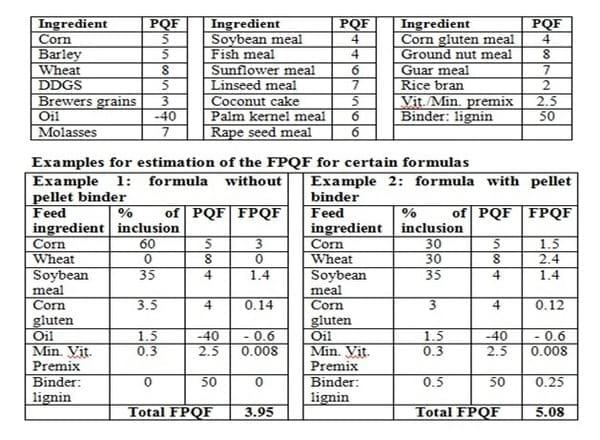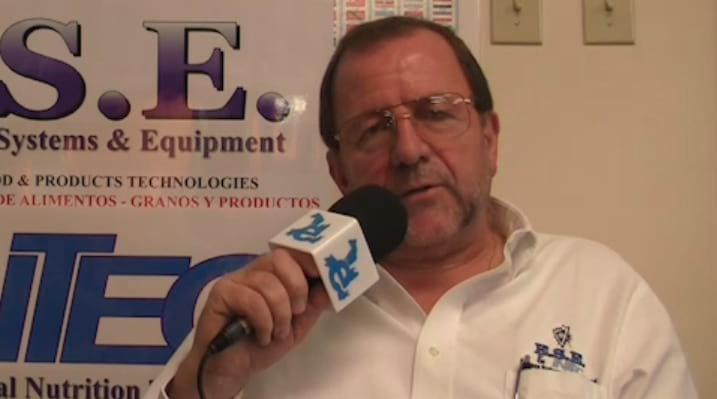Good quality feed pellets - Does it make sense?
Published: June 9, 2017
By: Mahmoud Farahat, Ph.D.
/ Consulting Nutritionist - Zagazig University.
Introduction
Feed pelleting can be defined as conversion of finely ground mash feed into dense, free flowing pellets or capsules, in a process involves steam injection (moisture & heat) and mechanical pressure.
There are several advantages for feeding broilers on pelleted rather than mash feed. The main advantage is the improved bird performance (improved feed intake, weight gain and feed conversion). Birds fed pelleted diets spend less time and need lower maintenance energy requirements during eating and digestion in comparison to those fed on mash feed. The other benefits of feeding pelleted diets include increase feed density, decrease feed dustiness, wastage and selection, better mechanical handling of feed in the feed lines, and destruction of feed-borne pathogens. Therefore, the full genetic potentials of modern broiler strains cannot be achieved without pelleted feed.
In order to achieve these multi-benefits, the pellet durability should be of a standard quality (not contain too much fines), otherwise, the bird performance will be adversely affected.
Pellet quality
High quality pellets can be defined as pellets that can withstand repeated handling as that reported during bagging, transportation, storage, and moving in feed lines without excessive breakage or generation of fine particles. Pellet quality is usually expressed as the pellet durability index (PDI), and measured by using tumbling can device, in which the pellet sample to be tested is first sieved to remove fines, then tumbled in the tumbling can device for a defined period of time. The tumbled sample is then sieved to remove fines, and the amount of intact pellets is determined. The PDI can be calculated as following: weight of intact pellet after tumbling / weight of intact pellet before tumbling x 100. Other devices can be used to determine the pellet durability such as Holmen pellet tester, lignotester, etc.
Factors affecting pellet quality
1) Feed formulation
Some feed ingredients have good impact on pellet quality, while others could adverse the quality. Unfortunately, corn-soy diets are not the ideal diets that could achieve the desired pellet quality. Dietary inclusion of wheat grain or wheat by products (wheat midds, wheat gluten) can increase pellet durability, because of the high protein (gluten) and hemi-cellulose content of wheat in comparison to corn or corn co-products. Similarly inclusion of oat as a partial substitute of corn can increase pellet quality. We can rank feed grains according to their positive impacts on pellet quality from best to worst as followings: oat, wheat, barley, corn, sorghum.
It was previously known that starch and its gelatinization is the most important factor for achieving the desired pellet quality. However, recent reports indicated that the positive impact of protein on pellet quality is much more important than that of starch.
Dietary inclusion of oil has an adverse effect on pellet quality. This is attributed to the coating effect of oil to the feed particles which prevent their penetration by the steam, also oil reduces the friction generated between die and fed particles with subsequent decrease in the starch gelatinization rate.
Inclusion of binding agents (e.g. water (simplest binder), lignin sulphonate, hemicelluloses extract, gelatin, etc.) and/or surfactants can increase pellet quality, pellet throughput, and lower power consumption.
Feed pellet quality factor (FPQF): is a tool developed by Borregaard lignotech and used to predict the pellet quality of the feed formula.
Estimation of the FPQF for certain feed formula: each feed ingredients has a pellet quality factor (PQF). The PQF has a score from 0 to 10, where 0 predict poor pellet and 10 predict good pellet. We can estimate the FPQF for each ingredient by multiplying the PQF by the % of inclusion of the feed ingredient in the formula. The overall FPQF equals the sum of the FPQF of all ingredients used in the formula. Generally, values below 4.7 are indicators for poor pellet quality, while values higher that 4.7 are indicators for good pellet quality.
Pellet quality factor for certain feed ingredients

2) Feed ingredients particle size
Although doubted by some researchers, it is accepted that decreasing ingredient’s particle size has a good influence on pellet quality. However, over grinding is not recommended to avoid power wastage, reduced production rate and suboptimal gizzard development. On the other hand, coarse grinding eases pellet break down and decreases starch gelatinization (high degree of gelatinization is required to produce good pellets).
3) Steam conditioning
When mash feed passes through the conditioner, it will expose to high pressure steam. This steam provides the heat and moisture required for starch gelatinization, particles adhesion, feed semi-digestion, and feed pathogens damage. The steam temperature and the time that mash feed is stayed in the conditioner have major influence on the durability of the produced pellets. Conditioning the feed at a temperature of 80° C is sufficient to produce good quality pellets. The minimum time that feed should stay in the conditioning tube to produce durable pellets is 30 seconds. Long time conditioners, in which the feed can stay in the conditioner for about 3-4 minutes, can be used to improve pellet stickiness.
4) Die/roll specifications
Pellets are produced via roll pressing of the hot mash against metal die. Thicker dies (long die channels) have a positive impact on pellet durability due to increasing the friction time between feed particles and die wall with subsequent more starch gelatinization. Most of starch gelatinization occurs when feed passes through the dies. Similar result can be obtained via using small hole dies. This means that dies of 60 mm thickness are better than those of 50 or 40 mm thickness, and that dies with holes of 3 mm diameter are better than those with holes of 5 mm diameter. However, using thicker or small holes dies have negative impact on pellet throughput. Additionally, increasing the distance between roll and die from 0.1 to 2 mm resulted in an increase in the pellet durability.
5) Cooler
After leaving pellet mill, the temperature of the pellets is ranged from 70-90? C and the moisture is ranged from 15-17%. Proper cooling (via using stream air cooling machine) is required to lower pellet temperature to about 8? C above the ambient temperature, and moisture % to be 12%. The cooling machine can be of either horizontal or vertical types. Quick cooling leads to removal of more moisture and heat from the surface of the pellets than their core, and the resultant pellets will be brittle. On the other hand, prolonged cooling produces very dry pellets that can be exposed to abrasion and can be of low palatability.
References
1- Abdollahi, M. R., Ravindran, V. and Svihus, B. (2013). Pelleting of broiler diets: An overview with emphasis on pellet quality and nutritional value. Anim. Feed Sci. Technol. 179:1-23.
2- Payne, J. D. (2006). Troubleshooting the pelleting process: in Feed Technology Technical Report Series. American Soybean Association International Marketing.
3- Payne, J., Rattink, W., Smith, T. and Winowiski, T. (2001). The Pelleting Handbook: A guide for production staff in the compound feed industry. Borregaard lignotech.
2- Payne, J. D. (2006). Troubleshooting the pelleting process: in Feed Technology Technical Report Series. American Soybean Association International Marketing.
3- Payne, J., Rattink, W., Smith, T. and Winowiski, T. (2001). The Pelleting Handbook: A guide for production staff in the compound feed industry. Borregaard lignotech.
Related topics
Authors:
Join to be able to comment.
Once you join Engormix, you will be able to participate in all content and forums.
* Required information
Would you like to discuss another topic? Create a new post to engage with experts in the community.
Create a postHangzhou DE Mark Industrial Co Ltd
28 de octubre de 2017
Inclusion of binding agents (e.g. water (simplest binder), lignin sulphonate, hemicelluloses extract, gelatin, etc.) and/or surfactants can increase pellet quality, pellet throughput, and lower power consumption.
-------------------------------------------------------
I totally agree with Dr.Farahat. Pellet binder plays a very important role in improving pellet integrity and reducing dust.
4 de julio de 2017
30 sec conditioning is too low a time
Now a days it is recommended for 120 seconds
for better conditioning and better gelatinisation
to have compact pellet
Regards
Dr sushil chandra
25 de junio de 2017
Pl visit a pellet mill and try to produce pellets without steam, you will have your own experience and the answer
This will be seeing is believing
Regards
Dr sushil chandra
15 de junio de 2017
Good article on pellet vs mash
My reply to Mr Ambalkar on producing pellet without steam.
Pl note that steam requirement for geletinization of feed particles and for also increasing the temp of mix feed to the tune of 75 degree and above so that at high temp and pressure material can pass thru die of 3 mm to make compact pellet
Pellets are complete feed
Regards
Dr chandra
12 de junio de 2017
I totally agree with you Doc, feeding broilers on pelleted feeds enhance a positive growth performance on the birds in terms of final live weight, FCR and reduce feed wastage thereby reducing the cost of production.
30 de octubre de 2017
And in what proportions is lignin sulfonate added?
Does it harm the health of hydrobionts?
Azeus Fish Feed Machine
4 de julio de 2017
Dry type fish feed extruder is without steam, contributes to making pellets of different diameters (0.9-15mm) and shapes. Easier to use and operate.
ANDREWS FEEDS
4 de julio de 2017
With regard to cooling, how do you think it effects PDI?
Example, suppose feed is conditioned with steam at 75deg for 30sec pelletted and then cooled to within 6 degrees of ambient. What difference does it make if ambient is 18deg or 28deg?














.jpg&w=3840&q=75)